Public Safety Canada Portfolio Overview and Organisational Charts
Public Safety and Emergency Preparedness Portfolio
The Public Safety Portfolio is composed of the Department of Public Safety and Emergency Preparedness (the DepartmentFootnote1, PS) and five agencies: Royal Canadian Mounted Police (RCMP), the Canada Border Services Agency (CBSA), the Canadian Security Intelligence Service (CSIS), the Correctional Service of Canada (CSC), and the Parole Board of Canada (PBC), and three review bodies: the Civilian Review and Complaints Commission for the RCMP (CRCC), the Office of the Correctional Investigator (OCI), and the RCMP External Review Committee (ERC).
The Portfolio is the biggest, non-military Portfolio in the Government of Canada. The Portfolio’s 2023-24 budget is more than $10 billion, and it employs close to 72,000 full-time equivalents working in every part of the country and internationally. Each organization contributes to the public safety agenda through its unique mandate and responsibilities.
The Department’s principal role is to bring strategic focus, coordination and direction to the government’s overall safety and security agenda. It plays a key role in the development, coordination and implementation of policies in the areas of national security, community safety, crime prevention, law enforcement and emergency management, and maintains a presence in regional offices across the country and in Washington, D.C. The Department provides transfer payments and support to various programs, including crime prevention, border policy, disaster mitigation, preparedness and recovery, search and rescue, serious and organized crime, countering radicalization to violence, cyber security and critical infrastructure. The largest include: Disaster Financial Assistance Arrangements, First Nations Policing Program, National Disaster Mitigation Program, Gun and Gang Violence Action Fund and the National Crime Prevention Strategy.
The Department also maintains the Government Operations Centre (GOC), a 24/7 facility that supports preparedness and coordinates the integrated federal response to all-hazard events of national interest (e.g. the 2016 wildfire in Fort McMurray, the 2020 Nova Scotia mass shooting, and the COVID-19 Pandemic). The vast majority of the Department’s employees work in the National Capital Region, but regional offices are also located in five regions: Ontario, Quebec and Nunavut, Atlantic, Prairies and Northwest Territories, and Pacific (British Columbia and Yukon) regions.
The RCMP provides federal policing services to all Canadians and policing services under contract to the three territories, eight provinces (except Ontario and Quebec), more than 150 municipalities, more than 600 Indigenous communities and three international airports. The RCMP offers coordinated and integrated programs to all law enforcement and criminal justice officials in Canada to assist in the detection and investigation of crime, and to ensure sound prosecutions. This includes preventing, detecting and investigating offences against federal statutes; maintaining law and order; providing investigative and protective services to other federal departments and agencies; and providing Canadian and international law enforcement agencies with specialized police training and research, forensic laboratory services, identification services and informatics technology. The RCMP has liaison officers and criminal intelligence analysts deployed in other countries, and is engaged in peacekeeping and international capacity building. The RCMP is led by a Commissioner, who is appointed for an unspecified term.
The CBSA provides integrated border services by enforcing Canadian laws governing trade and travel (as well as international agreements and conventions), facilitating legitimate cross-border traffic, assessing and collecting duties and taxes and interdicting goods and people that pose a potential threat to Canada. This includes immigration enforcement, such as the removal of people who are inadmissible to Canada for terrorism, organized crimes, war crimes or crimes against humanity. The CBSA provides services at approximately 1,200 points across Canada and abroad, including international airports, land ports of entry, and remote border crossings. The CBSA is led by a President, who is appointed to a term of no more than five years.
CSIS investigates and assesses activities that may be suspected of posing threats within or outside Canada, and has the authority to take threat reduction measures, subject to limitations. CSIS supports other government departments and agencies through its security screening programs, provides security assessments to Government and plays a critical role in immigration processes through security advice to CBSA and Immigration, Refugees and Citizenship Canada (IRCC). Upon request from the Minister of Foreign Affairs or the Minister of National Defence, CSIS collects foreign intelligence within Canada to support the Government’s broader national interests. CSIS has resources dispersed across Canada and internationally to investigate threats and to liaise with domestic and international partners working within Canada and abroad. CSIS is led by a Director, who is appointed to a term of no more than five years. This appointment can be renewed as long as the aggregate term does not exceed ten years.
CSC administers court-imposed sentences of two years or more for adult offenders, supervises offenders on various forms of conditional release in the community, and helps protect society by encouraging offenders to become law-abiding citizens while exercising reasonable, safe, secure and humane control. CSC also administers post-sentence supervision of offenders with Long-Term Supervision Orders for up to 10 years and provides services to victims of crime, such as information sharing and awareness building to support victims. It is responsible for the management of 43 institutions of various security levels, including six Indigenous healing lodges. CSC is led by a Commissioner, who is appointed for an unspecified term.
PBC is an independent administrative tribunal that reports to Parliament through the Minister of Public Safety and has exclusive authority to make independent, quality conditional release, record suspension and expungement decisions, as well as clemency recommendations in a transparent and accountable manner. The Board’s authority extends to federal offenders and offenders in provinces and territories that don’t have their own parole boards. The Board also imposes conditions on any kind of conditional release and can order certain offenders to be held in prison until the end of their sentence. The PBC makes pardons, record suspensions and expungement decisions, and makes recommendations for the exercise of clemency through the Royal Prerogative of Mercy. The Board is led by a Chairperson who is appointed for a term of up to five years.
The CRCC is an independent agency created by Parliament to ensure that public complaints made about the conduct of RCMP members are examined fairly and impartially. The CRCC receives complaints from the public about the conduct of RCMP members; conducts reviews when complainants are not satisfied with the RCMP’s handling of their complaints; initiates complaints and investigations into RCMP conduct when it is in the public interest to do so; holds hearings; undertakes systemic reviews and reports findings and makes recommendations. The Commission consists of a Chairperson, who is appointed to a five-year term, and a maximum of four other members, one of whom may be named the Vice-Chairperson.
The primary responsibility of the OCI is to investigate and bring resolution to individual offender complaints. The Office conducts independent investigations into the problems of offenders related to decisions, recommendations, acts or omissions related to the CSC that affect offenders either individually or as a group. The OCI may initiate an investigation based on a complaint from (or on behalf of) an offender, at the request of the Minister of Public Safety, or on its own initiative. The Office is also responsible for reviewing and making recommendations on CSC’s policies and procedures associated with the area of individual complaints to ensure that systemic areas of concern are identified and appropriately addressed. The Office is headed by a Correctional Investigator, who is appointed for a term of up to five years.
The RCMP ERC provides civilian oversight of labour relations within the RCMP. It aims to promote fair and equitable relations by conducting independent reviews of certain types of grievances, appeals on formal disciplinary measures and demotion cases, and provides non-binding recommendations to the RCMP Commissioner. The Committee may institute hearings, summon witnesses, administer oaths and receive and accept evidence. The Committee is headed by a Chairperson, who is appointed to a three-year term.
2023-24 Budget and Full-Time Equivalents (FTEs):
- PS: $2.6 billion / 1,427 FTEs
- RCMP: $4.2 billion / 32,119 FTEs
- CBSA: $2.7 billion / 15,812 FTEs
- CSIS: $660 million / 3,400 FTEs
- CSC: $3.0 billion / 18,511 FTEs
- PBC: $70.5 million / 536 FTEs
- CRCC: $15.7 million / 103 FTEs
- OCI: $5.6 million / 41 FTEs
- ERC: $6.5 million / 23 FTEs
Portfolio and Departmental Organizational Chart
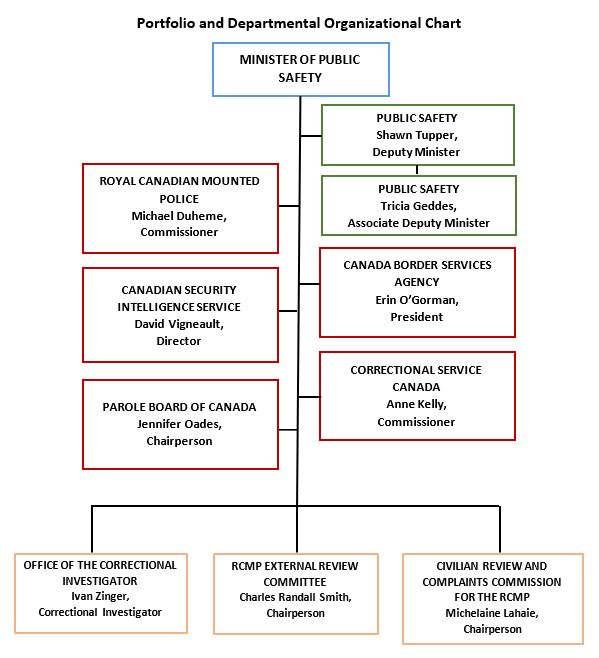
Image Description
Portfolio and Departmental Organizational Structure
Minister of Public Safety
Public Safety
Shawn Tupper
Deputy Minister
Public Safety
Tricia Geddes
Associate Deputy Minister
Royal Canadian Mounted Police
Michael Duheme,
Commissioner
Canadian Security Intelligence Service
David Vigneault,
Director
Parole Board of Canada
Jennifer Oades,
Chairperson
Canada Border Services Agency
Erin O’Gorman,
President
Correctional Service of Canada
Anne Kelly,
Commissioner
Office of the Correctional Investigator
Ivan Zinger,
Correctional Investigator
RCMP External Review Committee
Charles Randall Smith,
Chairperson
Civilian Review and Complaints Commission for the RCMP
Michelaine Lahaie,
Chairperson
Public Safety Canada Organizational Structure
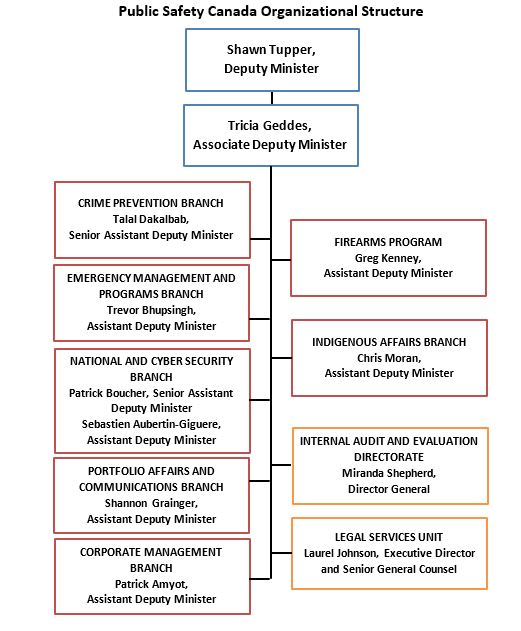
Image Description
Public Safety Canada Organizational Structure
Shawn Tupper,
Deputy Minister
Tricia Geddes,
Associate Deputy Minister
Crime Prevention Branch
Talal Dakalbab,
Senior Assistant Deputy Minister
Emergency Management and Programs Branch
Trevor Bhupsingh,
Assistant Deputy Minister
National and Cyber Security Branch
Patrick Boucher,
Senior Assistant Deputy Minister
Sebastien Aubertin-Giguere,
Assistant Deputy Minister
Portfolio Affairs and Communications Branch
Shannon Grainger,
Assistant Deputy Minister
Corporate Management Branch
Patrick Amyot,
Assistant Deputy Minister
Firearms Program
Greg Kenney,
Assistant Deputy Minister
Indigenous Affairs Branch
Chris Moran,
Assistant Deputy Minister
Internal Audit and Evaluation Directorate
Miranda Shepherd,
Director General
Legal Services Unit
Laurel Johnson,
Executive Director and Senior General Counsel
Royal Canadian Mounted Police Organizational Structure
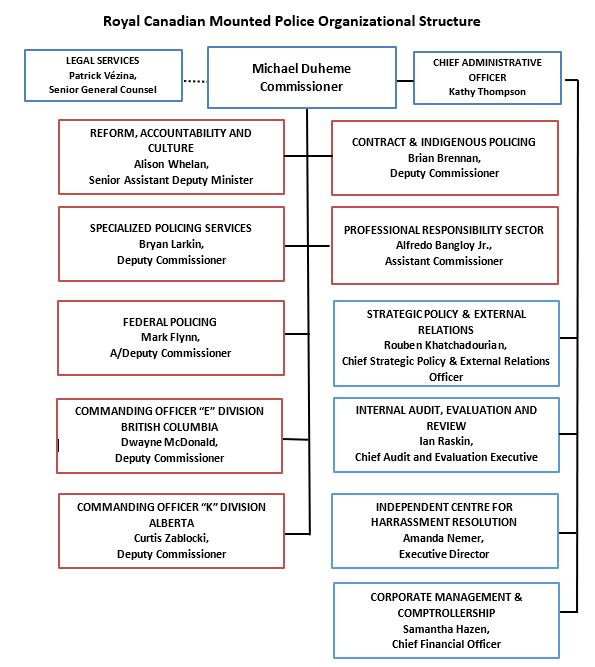
Image Description
Royal Canadian Mounted Police Organizational Structure
Michael Duheme
Commissioner
Legal Services
Patrick Vézina,
Senior General Counsel
Kathy Thompson
Reform, Accountability and Culture
Alison Whelan,
Senior Assistant Deputy Minister
Specialized Policing Services
Bryan Larkin,
Deputy Commissioner
Federal Policing
Mark Flynn,
A/Deputy Commissioner
Commanding Officer “E” Division British Columbia
Dwayne McDonald,
Deputy Commissioner
Commanding Officer “K” Division Alberta
Curtis Zablocki,
Deputy Commissioner
Contract & Indigenous Policing
Brian Brennan,
Deputy Commissioner
Professional Responsibility Sector
Alfredo Bangloy Jr.,
Assistant Commissioner
Strategic Policy & External Relations
Rouben Khatchadourian,
Chief Strategic Policy & External Relations Officer
Internal Audit, Evaluation and Review
Ian Raskin,
Chief Audit and Evaluation Executive
Independent Centre for Harrassment Resolution
Amanda Nemer,
Executive Director
Corporate Management & Comptrollership
Samantha Hazen,
Chief Financial Officer
Canada Border Services Agency Organizational Structure
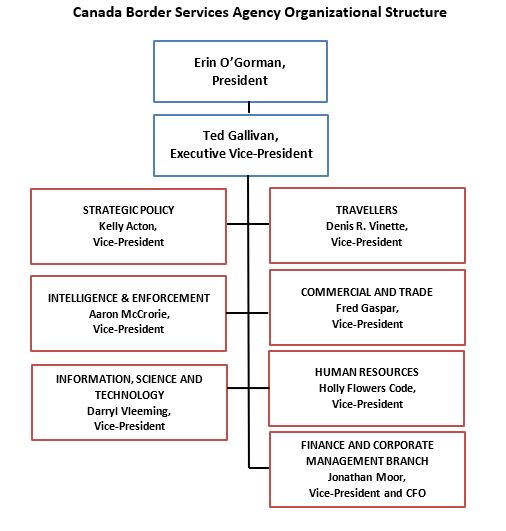
Image Description
Canada Border Services Agency Organizational Structure
Erin O’Gorman,
President
Ted Gallivan,
Executive Vice-President
Strategic Policy
Kelly Acton,
Vice-President
Intelligence & Enforcement
Aaron McCrorie,
Vice-President
Information, Science and Technology
Darryl Vleeming,
Vice-President
Travellers
Denis R. Vinette,
Vice-President
Commercial and Trade
Fred Gaspar,
Vice-President
Human Resources
Holly Flowers Code,
Vice-President
Finance and Corporate Management Branch
Jonathan Moor,
Vice-President and CFO
Canadian Security Intelligence Service Organizational Structure
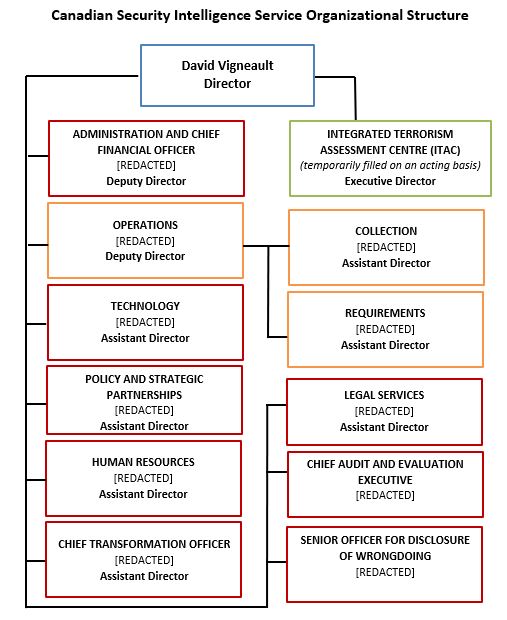
Image Description
Canadian Security Intelligence Service Organizational Structure
David Vigneault
Director
Administration and Chief Financial Officer
[REDACTED],
Deputy Director
Operations
[REDACTED],
Deputy Director
Technology
[REDACTED],
Assistant Director
Policy and Strategic Partnerships
[REDACTED],
Assistant Director
Human Resources
[REDACTED],
Assistant Director
Integrated Terrorism Assessment Centre (ITAC)
(temporarily filled on an acting basis)
Executive Director
Collection
[REDACTED],
Assistant Director
Requirements
[REDACTED],
Assistant Director
Legal Services
[REDACTED],
Assistant Director
Chief Audit and Evaluation Executive
[REDACTED]
Senior Officer for Disclosure of Wrongdoing
[REDACTED]
Correctional Service of Canada Organizational Structure
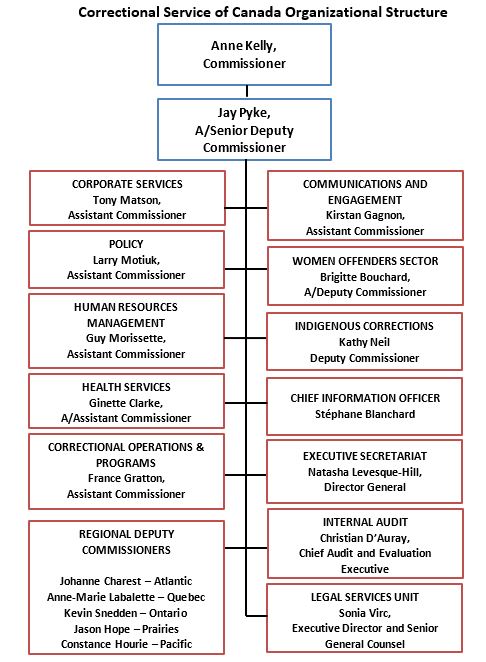
Image Description
Correctional Service of Canada Organizational Structure
Anne Kelly,
Commissioner
Jay Pyke,
A/Senior Deputy Commissioner
Corporate Services
Tony Matson,
Assistant Commissioner
Policy
Larry Motiuk,
Assistant Commissioner
Human Resources Management
Guy Morissette,
Assistant Commissioner
Health Services
Ginette Clarke,
A/Assistant Commissioner
Correctional Operations & Programs
France Gratton,
Assistant Commissioner
Regional Deputy Commissioners
Johanne Charest – Atlantic
Anne-Marie Labalette – Quebec
Kevin Snedden – Ontario
Jason Hope – Prairies
Constance Hourie – Pacific
Communications and Engagement
Kirstan Gagnon,
Assistant Commissioner
Women Offenders Sector
Brigitte Bouchard,
A/Deputy Commissioner
Indigenous Corrections
Kathy Neil,
Deputy Commissioner
Chief Information Officer
Stéphane Blanchard
Executive Secretariat
Natasha Levesque-Hill,
Director General
Internal Audit
Christian D’Auray,
Chief Audit and Evaluation Executive
Legal Services Unit
Sonia Virc,
Executive Director and Senior General Counsel
Parole Board of Canada Organizational Structure

Image Description
Parole Board of Canada Organizational Structure
Jennifer Oades,
Chairperson
Sylvie Blanchet,
Executive Vice-Chairperson
Daryl R. Churney,
Deputy Chairperson
Anik Lapointe,
Chief Financial Officer
Nicole Robichaud,
Senior Legal Counsel
Benoit Lamarche,
Chief of Staff
Appeal Division
Geneviève Boudreau,
Vice-Chairperson
Regional Vice-Chairpersons
François Levert – Atlantic
Francine Cantin – Québec
Douglas Kirkpatrick – Ontario
Amy Agar (Interim) – Prairies
Kevin D’Souza – Pacific
Footnotes
- 1
The Department’s legal name is the Department of Public Safety and Emergency Preparedness. The Department is commonly referred to as Public Safety Canada (PS). The legal name must be used in statutory instruments, such as legislation or Orders in Council, as well as other types of documents that have legal effect, including contracts or other formal agreements.
- Date modified: